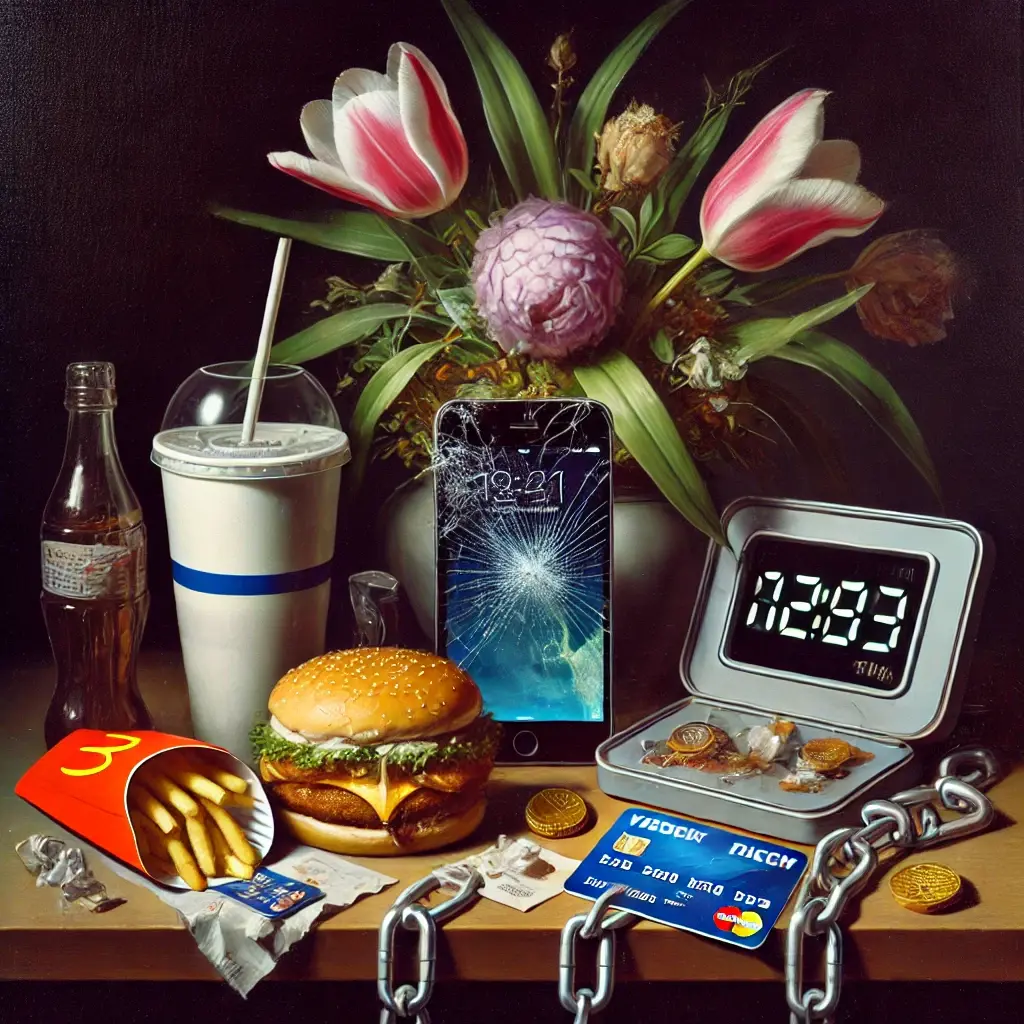Lane Wallace is a dedicated high school teacher with a background in psychology, law, and history, bringing real-world insights into his College & Career Readiness and Intro to Law classes. With experience teaching subjects ranging from World and U.S. History to Drama, he emphasizes practical applications to equip students with essential life skills. Lane created a modern still-life using AI in response to an assignment prompt.
Inspired by the Dutch still-life tradition, my piece, “Echoes of the Digital Age,” explores themes of impermanence, technological reliance, and blending the digital and physical worlds. Dutch still-life paintings often depicted objects that symbolized wealth, mortality (vanitas), and the fleeting nature of life. My modern interpretation maintains this reflective quality while incorporating contemporary symbols relevant to today’s society.
Symbolism & Meaning
A Cracked Smartphone – Representing both connection and disconnection, the smartphone epitomizes our reliance on technology for communication, information, and entertainment. The crack symbolizes fragility—how easily we lose control over the tools that dominate modern life and the delicate balance between dependence and vulnerability.
A Half-Eaten Fast-Food Meal – Inspired by the decaying fruits in Dutch Vanitas paintings, this element speaks to overconsumption, convenience culture, and the fleeting nature of instant gratification in today’s fast-paced world. It captures the transient satisfaction of modern indulgence and its inevitable decay.
A Digital Clock with Glitching Numbers – Time, a central theme in traditional Dutch still-life paintings, was often represented by hourglasses or melting candles. The distorted, flickering digital clock reflects our altered perception of time in an age dominated by technology and rapid-paced, screen-driven living.
A Credit Card Attached to Chains symbolizes the allure of financial freedom and the entrapment of debt in modern society. Drawing on the theme of wealth and economic power, this piece draws on 17th-century Dutch still-life art that often featured luxurious objects as symbols of prosperity; today, the credit card represents both access to wealth and the strain of financial obligations.
A Wilting Houseplant with Artificial Flowers – The juxtaposition of natural and synthetic elements reflects growing environmental concerns and the increasing artificiality in our surroundings. It also speaks to how society often cultivates the illusion of sustainability while overlooking deeper ecological issues.

These symbols reflect my personal observations of modern life—how technology shapes relationships, how consumer habits influence well-being, and how wealth often proves to be an illusion. The tension between authenticity and the artificial, a central theme in historical Dutch still-life works, continues to resonate in contemporary culture. I find myself caught in the pull of credit cards, bound by their accessibility and the strain they create; perpetually connected to my smartphone; opting for fast food over cooking, despite knowing the importance of healthier choices; experiencing a distorted sense of time, where one day blends into the next since quarantine; and, in an effort to avoid waste, supporting my wife’s preference for artificial flowers over real ones, despite the environmental implications.
Historical Context & Modern Narratives
Dutch still-life paintings often celebrated prosperity while subtly critiquing excess and mortality. Similarly, my work reflects on modern materialism and the fleeting nature of digital culture. Just as 17th-century artists incorporated skulls and decaying flowers as reminders of life’s impermanence, today’s digital glitches and financial entanglements act as a modern “memento mori,” urging us to reflect on what we truly value and why.
